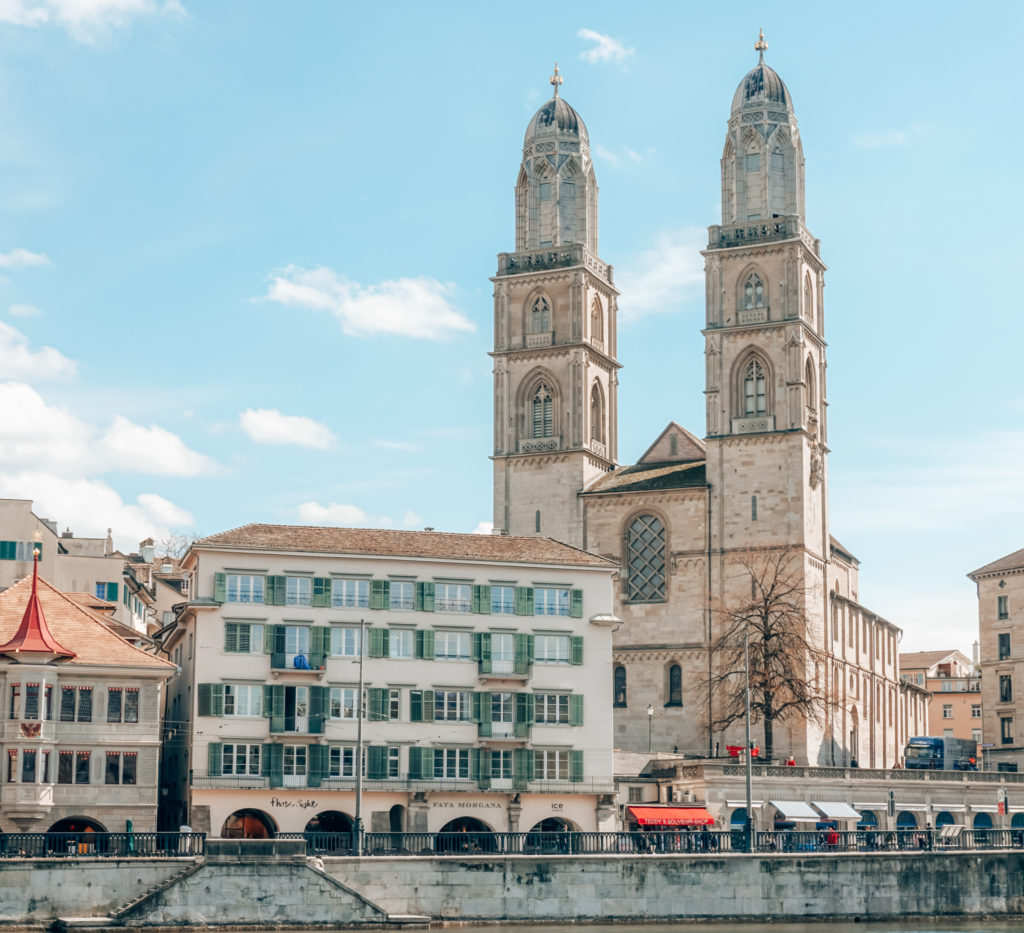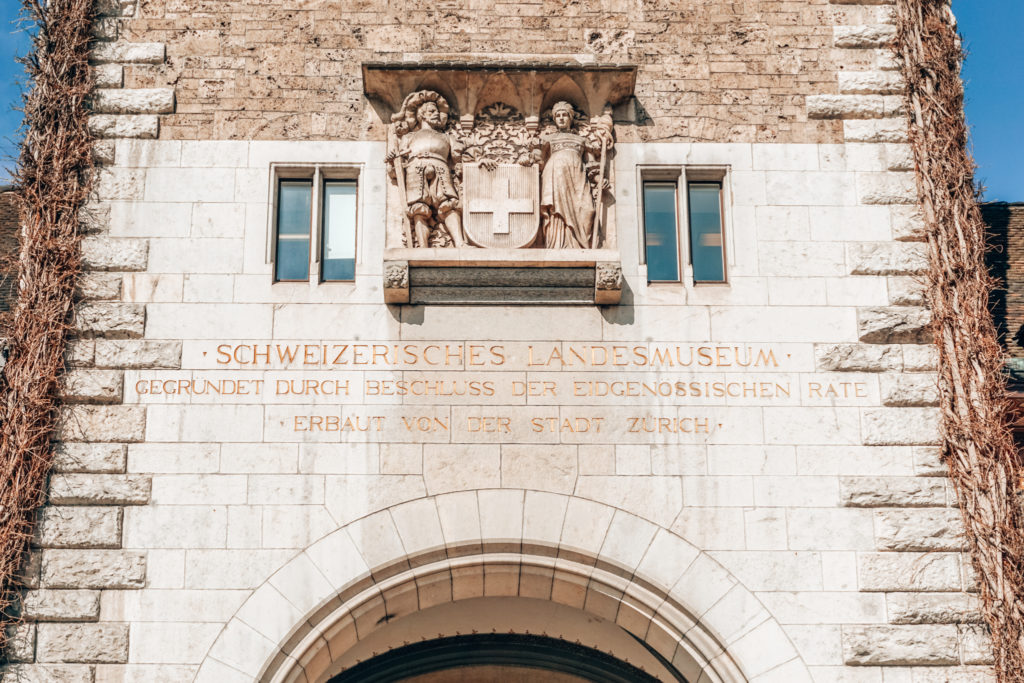Weekend in Zurich – top 10 things to see and do
Most people know Zurich only as Europe’s banking and finance hub, but it’s also a lovely and welcoming tourist destination. With the charming Limmat River running through it, it’s surrounded by spectacular nature and the nearby Alps, enticing people with their natural beauty. From quaint streets, beautiful architecture and a peaceful lake to quirky shops, delicious chocolates and football history, there’s something for everyone. And because Zurich is a walkable city, simply strolling around from place to place will allow you to see most of the attractions.
A downloadable PDF version of this blog can be found HERE.

Of course, there are more than 10 things worth seeing and doing in Zurich, but these are my favourite must-dos!
1. Grossmünster
The Grossmünster (“Great Minister”) church is a landmark of Zurich. Standing on an open terrace above the river, this principal church dominates the city skyline with its twin towers.
According to the legend, Charlemagne (Charles the Great, King of the Franks) discovered the graves of the city’s patron saints Felix and Regula. He had a church built as a monastery on the spot and it holds their crypts to this day.
It was built between the 11th and the 13th centuries and has had many different upgrades since then. Modern additions to the church include three colourful stained-glass windows in the choir, created by celebrated artist Augusto Giacometti, and Bronze sculpted doors by Otto Munch.


In the first half of the 16th century, the Grossmünster church was the starting point of the Swiss-German Reformation led by Huldrych Zwingli and Heinrich Bullinger.
For far-reaching city views, climb the southern tower, the Karlsturm. You can get knockout views of the whole city, the lake and the Alps beyond. From the nave, you have to climb 187 steps leading up to the viewing platform. The climb usually takes 30 minutes (up and down).


Visiting the church and the tower
Visiting the church is free, but you have to pay CHF 5 per person to climb Karlsturm (kids and students CHF 2). There is no need for pre-booking unless you’re a group of 5 or more. Audio guides are available with church tours in German, English, French, Italian and Romanesque and are included in the tower entrance.
Summer opening times: March 1 – October 31
Monday to Saturday, from 10 am to 5:30 pm
Winter opening times: November 1 – February 28
Monday to Saturday 10 am – 4.30 pm
Sundays: from 12.30 pm
You can find more information about the church on their website here.
2. Augustinergasse
This is one of Zurich’s most beautiful historical narrow streets with many bay windows along it. This medieval lane is completely pedestrianised and connects the busy Bahnhofstrasse with the former 13th-century Gothic Augustiner Church. And it was named after it!




The highlight of Augustinergasse is the numerous carved and colourfully painted wooden bay windows. These served not only to provide light but also were an old-school CCTV system! That is, they provided the possibility to see who was at the door. As they were never built directly above the entrance, but slightly offset, residents could spot unwanted guests from afar and elegantly avoid them.
3. Fraumünster Church
Known as the Women’s Church, it is considered one of Zurich’s most prominent landmarks. Founded in 853 by King Louis the German for his daughter Hildegard, the church with its convent was inhabited by the female members of the aristocracy of Europe for 700 years.
It is renowned for its beautiful stained-glass windows, designed by the Russian-Jewish master Marc Chagall in the 1970s. The series of five almost 9-metres high windows in the choir stalls and the rose window in the southern transept are the church’s most stunning treasures. Another significant glass window is “The Heavenly Paradise” (1945) by Augusto Giacometti in the north transept.


Also, the organ in the Fraumünster Church with 5793 pipes, is the largest in the Canton of Zurich.
Visiting times:
From November 1st to February 29th – 10 am to 5 pm
From March 1st to October 31st – 10am until 6 pm
The admission fee costs CHF 5 per person and includes access to the crypt museum and an audio guide OR an illustrated brochure (in one of eight languages). Free entry for children up to 16 years of age, students, and apprentices.
For more information, you can visit Fraumünster Church’s official website.
4. Lindenhof Hill
The Lindenhof Hill is located in Zurich Altstadt (Old Town) in the Lindenhof quarter. It sits approximately 25 metres above the River Limmat and you can access it only on foot through the narrow streets.


This hilltop park planted with 90 lime trees (or linden trees – hence the name) and decorated with a fountain, provides glorious views of the city. From the terrace, you can admire the Old Town, Grossmünster Church, City Hall, the Limmat River and the Swiss Federal Institute of Technology.


Lindenhof Hill is a haven of peace and tranquillity in the heart of the city, a meeting point for passionate chess players, the boules players and tourists enjoying a break.






Lindenhof is where the historical town of Zurich evolved from the Celtic and Roman settlements and flourished. In the 4th century, it was the site of a Roman fort and in the 9th century, the grandson of Charlemagne built a regal palace here as a place of residence.
Also, the oath sealing of the Helvetic Constitution took place in Lindenhof in 1798.
5. Church of St. Peter
St Peterskirche is the oldest parish church in Zurich. Its foundations were laid in the 9th century and can still be seen today beneath the chancel.
The church didn’t have a tower in the pre- and early Romanesque times. The first big 3-storey tower was built in the early 13th century. The five tower bells are from 1880, with the largest weighing over six tons without its clapper.
Inside, the choir stalls date from the 13th century, but the rest of the church is largely an 18th-century reconstruction.
And the feature the church is famous for: the clock face! It measures 8.7m in diameter, making it the largest in Europe.




The Church will remain closed until October 2025 due to renovation work. In November and December 2024, it will be open for services.
6. Zürichsee / Lake Zurich


It is the focal point of Zurich and a favourite playground for both tourists and locals. The bent, almost banana-shaped glacier lake is 40 km long and of a maximum depth of 136 metres. It is one of Switzerland’s “Big Five” in terms of lakes (After Lake Geneva, Neuchâtel, Constance and Lake Lucerne).
In the past, it was mainly used as a traffic and transportation route, but today it is a popular excursion destination for swimming, sailing and boating.
There is no better way to enjoy Lake Zurich than along the lakeside boardwalk.




The entire shore is lined with promenades and parks, always busy with skaters, cyclists, swimmers and people just out for a stroll or a picnic. Along the promenade, you can admire great views from the Bürkliplatz, at the point where the Limmat River flows from the lake.
Starting from the Bellevue area, a boardwalk goes for about 3 kilometres along the water towards Tiefenbrunnen.
About 1.5 kilometres in you will find a beautiful Zürichhorn Park, built for the National Exhibition in 1939. Here you’ll also find a restaurant and a Chinese Garden.


Another lovely spot to admire the views from is a ferry dock Zürichhorn Casino, with a long deck. You can see the Glarus Alps on the horizon, such a beautiful sight!


Swimming and boat tours
Lake Zürich’s water is very clean and its temperature during summer reaches well beyond 20 °C. Therefore swimming in public baths and beaches is very popular.
The outdoor bathing facilities in Wollishofen, Mythenquai, Enge, Utoquai and Tiefenbrunnen are very well-frequented in the bathing season – but there are still plenty of other spots along the lake to take a refreshing dip.
Also, the lake’s water is purified and fed into Zürich’s water system, so it is potable!




The city has 11 official outdoor swimming baths on the lake and the river, many with facilities such as cloakrooms, toilets, kiosks etc. Most of them have an entrance fee (around CHF 8 for adults, CHF 6 for ages 16-20, and CHF 4 for kids). The ones on the river are usually free.
A really good way to enjoy the lake is to take a cruise! You can find a large number of companies offering passenger tours or take a ferry to some of the other towns on the lake. A regular boat service is running to most of the places around the shore all year round.
From the early mornings to sunset sailings, and musical or food-themed trips, there are all kinds of special excursions available. You can find out more on the ZSG’s website.
There are also four beautiful islands to explore in Lake Zurich. The tiny islands of Lützelau and Ufenau (with its St. Peter and Paul parish church) and Saffa Island, are particularly worthy of note. The last of these is connected to the mainland by a short footbridge and is a popular place to visit.
7. Bahnhofstrasse
It is Zurich’s main shopping boulevard and one of the world’s most exclusive retail strips. In 2011, a study named the Bahnhofstrasse the most expensive street for retail property in Europe and the third most expensive worldwide. In 2016 it ranked ninth.
Stretching for 1.4 kilometres from the main train station to Lake Zurich, the street is enlivened by fountains, public art, trees and prominent buildings. It is highly pedestrianized, except for trams.


Even if you can’t afford the price tags, it’s worth going window-shopping alone. Among the more than 90 shops, you’ll find famous designer names such as Tiffany & Co., Cartier, Mont Blanc and Prada.
It’s said the further south you go on Bahnhofstrasse, the more exclusive the stores become.
But expensive clothes and accessories are just one aspect of Bahnhofstrasse. You can indulge in chocolate at famous chocolatier shops, and visit galleries, florists or leather goods boutiques.
You can admire Bahnhofstrasse’s architecture and art as well. Many of the buildings are fine examples of 19th-century grandeur. For example, Das Haus zur Trülle at Bahnhofstrasse 69, has a gloriously elaborate roof. Also, the marble Rebekka-Brunnen Fountain, located close to Lake Zurich and the 1913 facade of the Peterhof building are worth the attention.


Paradeplatz, located at the heart of the Bahnhofstrasse, is the Swiss banking centre. The two biggest Swiss banks, UBS and the Credit Suisse Group have their headquarters there.
The square is also the site of a perilous X-crossing for trams and the renowned chocolate shop and cafe, Confiserie Sprüngli, is just on the corner.


Fun fact: This high-end street came from humble beginnings. It was created out of the exterior moat when the city’s walls were pulled down and was once called Fröschengraben, meaning the ditch of frogs.
8. Swiss National Museum
The National Museum is located behind the Main Station and houses the largest collection of artefacts documenting the cultural history of Switzerland, from the Stone Age to the present day.
The museum building was built in 1898 by Gustav Gull in the form of a French chateau. It contains more than 820,000 unique pieces like a large collection of silversmiths, textiles, costumes and religious wooden liturgy carvings.
A historical collection of Swiss coins dating back from the Middle Ages, an armoury tower, a great chivalry display and a Gothic art collection round out this excellent museum.


The permanent exhibition, “Simply Zurich”, on the first floor of the historical part of the museum is free of charge. It shows the diversity of the City and Canton of Zurich in a playful way. At the heart of the exhibition is a display case containing 60 objects, all of which tell a story of Zurich’s rich past.
The picturesque inner courtyard of the National Museum is often used for concerts and other events.
Opening hours:
Tuesday to Wednesday: 10.00am – 5.00pm
Thursday: 10.00 am – 7.00 pm
Friday to Sunday: 10.00am – 5.00pm
Entry to the Museum costs CHF 13 for adults and CHF 10 concessions. Children under 16 get in for free.
For more information about the Museum and its exhibitions, you can visit the Museum’s official website.
9. FIFA Museum
Spread over three floors and covering 3,500 square metres of exhibition space, the FIFA World Football Museum races you through the history of FIFA and the World Cup.
This interactive, multimedia world illustrates how the game stirs people’s emotions, and influences and inspires them daily, across the globe.
Along with the original FIFA World Cup™ Trophy, you can find here over 1,000 items of exclusive memorabilia and apparel, like the national soccer shirts of all the FIFA member associations.


A big highlight (at least for me it was) is the giant pinball machine, where you can test your ball skills. It’s guaranteed fun, even for non-skilled soccer fans!
Opening hours:
Tuesday to Sunday 10 am to 6 pm. The museum is closed on Mondays.
The ticket costs CHF 26 for an adult. There are also children, seniors and student discounts available. Children under 6 go in for free.
If you’d like to know more or buy tickets, you can visit the Museum’s official website.
10. FREITAG Tower
This is a skyscraper of a slightly different kind: 19 shipping containers stacked on top of each other, rising 26 metres into the air.
Located in Zurich-West, in the trendy Kreis 5 district, the recycled tower is home to a huge Freitag store, selling bags made from recycled truck tarpaulins, bicycle inner tubes and car seat belts. It’s fondly described as the “Bonsai Skyscraper” by the Friday brothers.


The rusty containers were sourced from Hamburg and transported to Zurich by train.
You can climb up to the observation deck, offering lovely views of the former industrial quarter.
You’ll be able to see the famous Prime Tower – Zurich’s tallest building, Frau Gerolds Garten – a popular urban garden community with a food market and small shops.




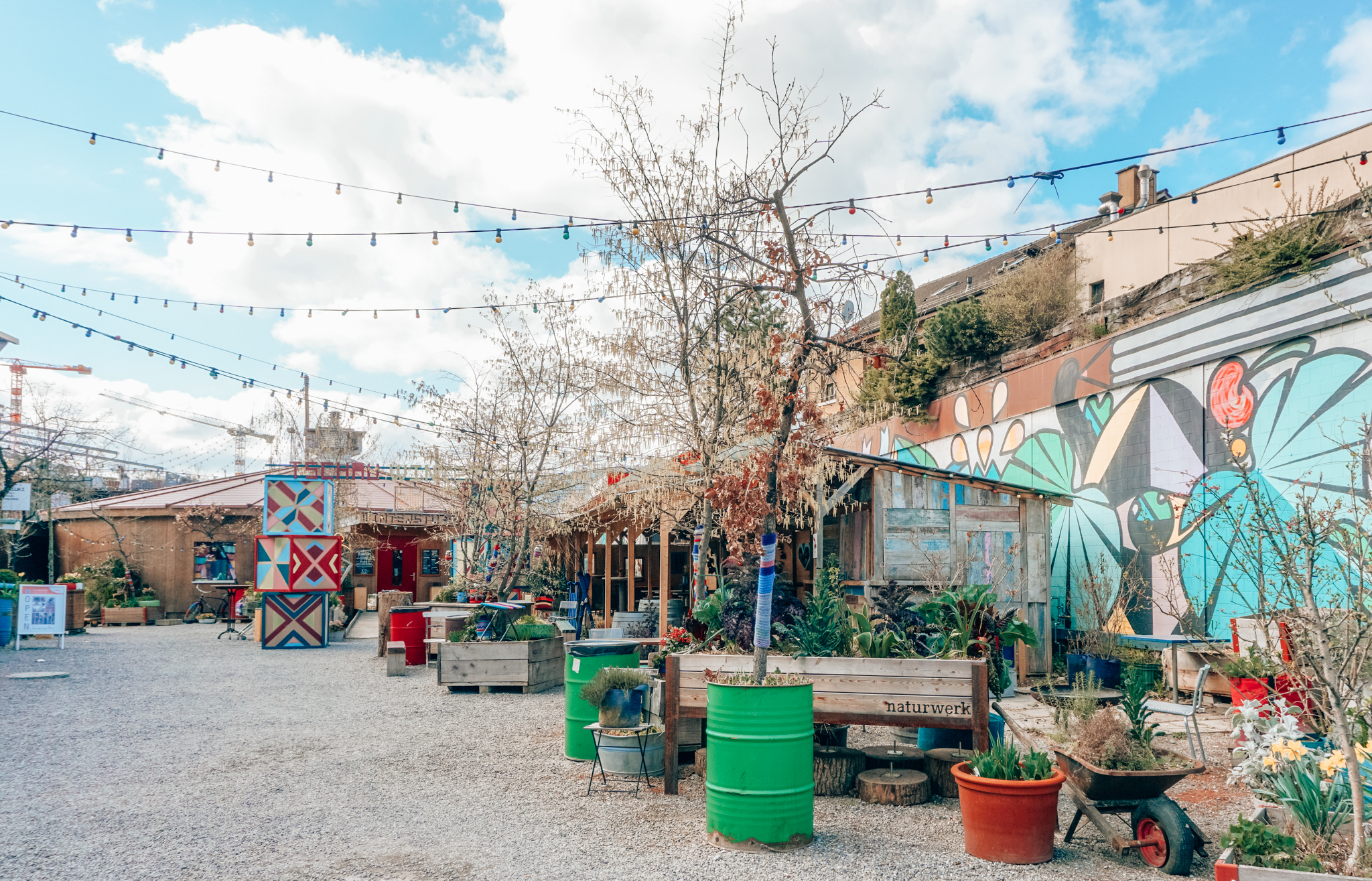

On the other side, you can spot the arches of the viaduct with cute boutiques, restaurants and event spaces.


Opening Hours:
Monday to Friday, 10.30am – 7.00pm
Saturday, 10.00am – 6.00pm
Address: Geroldstrasse 17, Zurich 8005
Bonus one: Try Swiss Food!
If you are planning to visit Zurich, experiencing Swiss cuisine is a must. It is highly inspired by German, Italian and French food culture, quite rich, diverse and features distinctive tastes. Since Switzerland is also famous for its meat and milk products, there are lots of delicious dishes to taste.
The most popular dish that you have to try is, of course, a cheese fondue. It originated in Switzerland and the first recipe was written here, in Zurich!
And the city‘s chefs are very creative when it comes to presenting fondue in its best light. You can get it in an open-air restaurant, on a boat, in a streetcar, in a cosy chalet or even in a tuk-tuk!




So order yourself a pot of hot, melted, flavoursome cheese, grab a long-stemmed fork and dip those bread cubes. It is a treat, especially on a cold day.
Here’s a list of a few places to get your fondue fix:
Swiss Chuchi Restaurant – the first fondue parlour in the old town of Zurich, serving traditional Swiss cuisine (that’s the one I went to).
Le Dézaley – the restaurant offers home-style specialities with French-Swiss hospitality and charm, accompanied by Zurich’s traditional crispy rösti potatoes.
Chalet Züriberg – High above the rooftops of Zurich, the cosy Fondue Chalet, which is built out of old timber, entices with its crackling open fire, candlelight, and winter culinary delights.
Fondue Tram – The oldtimer tram departs from Bellevue and passes by all of Zurich’s most beautiful places, while you indulge in your tasty fondue.
Tuk-Tuk tour with Fondue – The city tour combines a visit to the most beautiful spots in Zurich with classic Swiss cheese fondue and a bottle of white wine.
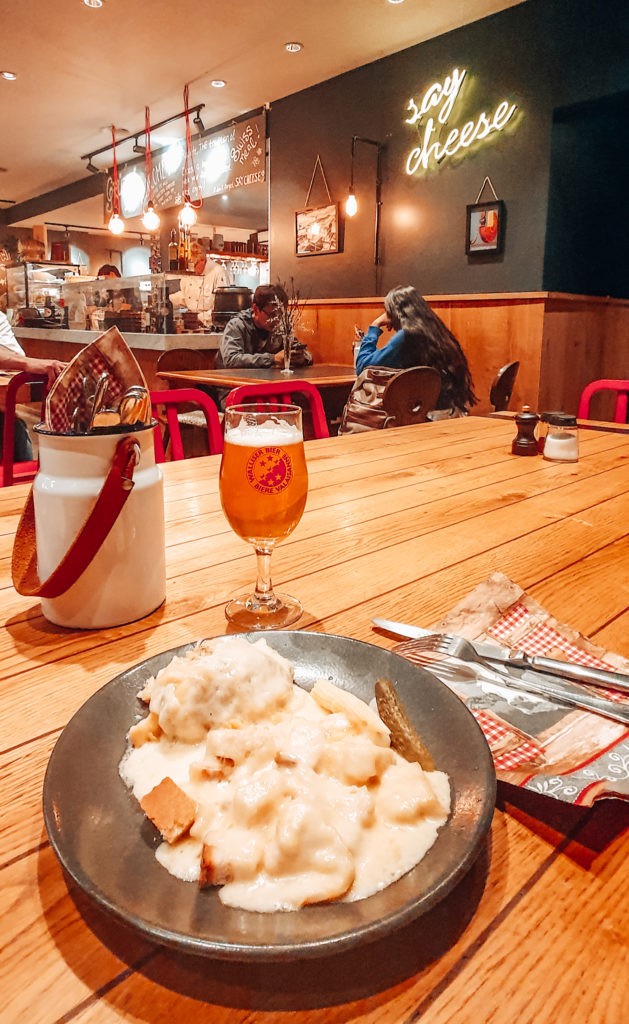

You can also try another version of melted cheese, Raclette, this time served with potatoes, cornichons or pickled onions. Visit Raclette Factory to see if it’s something you like.
Other traditional dishes you should put on your culinary list are: Zürcher Geschenzeltes (veal with potatoes), Birchermüesli, Zürcher Eintopf (hot-pot dish), Zürigschnätzlets (veal with cream sauce) or Stadtjäger sausage.
Let’s not forget about the famous Swiss chocolate! Zurich is crowned the country’s chocolate capital, so you can find some fine treats here.
The most popular place among tourists is the renowned Confiserie Sprüngli, making traditional chocolates since 1836. While there you can also taste the Luxemburgerli – colourful macaroons!


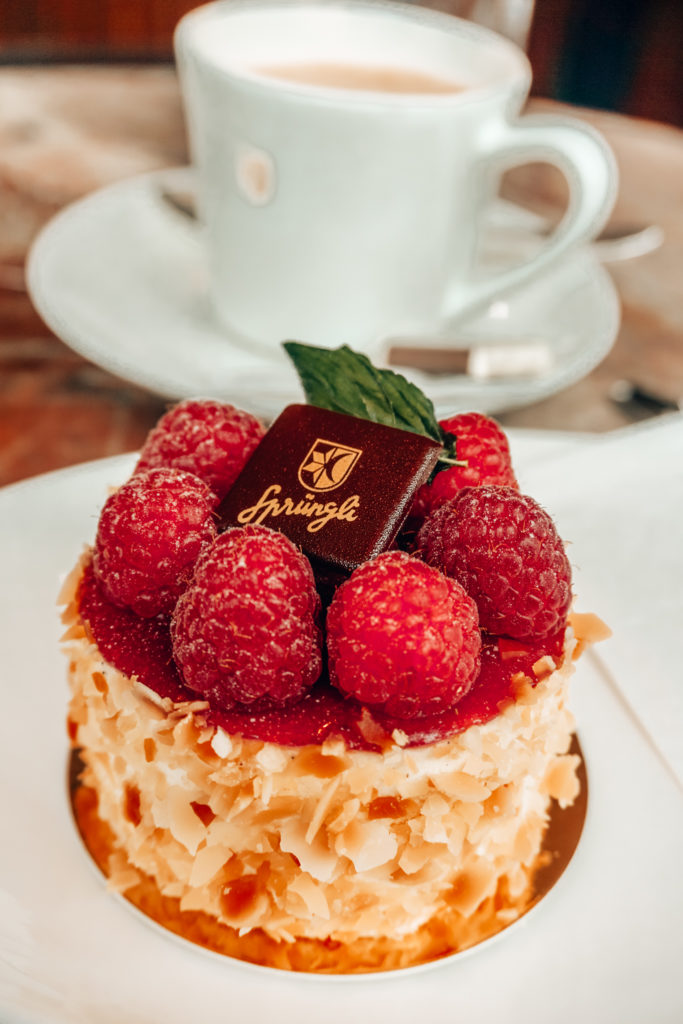



Other chocolate shops worth mentioning are Teuscher Chocolates, Max Chocolatier, Vollenweider, Läderach and Chocolat Dieter Meier (Oro de Cacao).
Useful INFO about Zurich:
Public Transport
Zurich is easy to navigate and very walkable. But if you prefer to use public transport, there is a modern, user-friendly network of trams and buses that covers the city daily from 5.30 am to midnight, with a more limited night service on weekends.
Transport works on a zone system, and tickets are valid for an hour. Tickets are transferable but must be bought before boarding. They are also valid on some boats and local city trains.
The most useful travel pass is the Tageskarte (one-day ticket) which allows travel on all buses and trams for 24 hours.
However, a good option for tourists is the ZurichCARD, which entitles the holder to unlimited free use of public transport, plus free or reduced admission to 43 museums. You can purchase the 24-hour ZurichCARD for CHF 29 (adult) and CHF 19 (children 6-16) or a 72-hour one for CHF 53 and CHF 37 respectively.
Travelling by taxi is quite expensive, but they are safe and convenient. You can either hail them on the street, find them at taxi ranks or order by phone.
Getting around by car is not recommended due to congestion and expensive or limited parking.
From mid-April to mid-October you can hire bicycles from stations around the city.
Getting to Zurich centre from the airport
Swiss Rail (SBB) provides fast and efficient transport to the city. You can easily find the station, which is located below the Arrivals Hall. The trains are quite frequent, leaving roughly every 10 minutes for Zurich and other destinations. It takes 10 minutes to get to the centre and fares depend on the type of pass and the number of city zones crossed.
Metered taxis are available outside Arrivals 1 and 2. The 15-minute taxi journey to Zurich costs around CHF 70.
The best time to travel to Zurich
Weather-wise July and August are the best times to visit Zurich, as it’s the middle of summer. But it is peak season as well, so hotel and flight prices are higher.
If you’d like to avoid summer crowds great options might be May–June and September–early October. Temperatures are brisker and hotel and flight prices decrease. Although you might want to pack an umbrella and a jumper, just in case.
If you’d like to visit lively Zurich during a festival, you might consider the Food Zurich (usually in June), Zurich Openair Festival (August) and Züri Fascht (June or July).
Shops opening hours
Shops in the city centre and around Bahnhofstrasse are usually open Monday to Friday 9 am to 8 pm. Smaller shops and those outside the centre might close earlier.
On Saturdays, you can expect shops in the centre to be open from 9 am to 5 pm, and big department stores like Jelmoli or Globus even until 8 pm.
On Sundays, only shops in railway and petrol stations are allowed to open.
Banks are open Monday to Friday 8:30 am to 4:30 pm.
I hope this quick guide introduced you to Zurich and invited you to visit this small, but charming city! If you have any questions, let me know 😊
Love,
Jo xx

